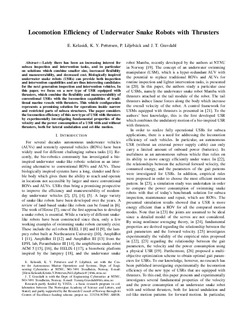| dc.contributor.author | Kelasidi, Eleni | |
| dc.contributor.author | Pettersen, Kristin Ytterstad | |
| dc.contributor.author | Liljebäck, Pål | |
| dc.contributor.author | Gravdahl, Jan Tommy | |
| dc.date.accessioned | 2016-11-07T10:58:30Z | |
| dc.date.accessioned | 2017-01-11T10:16:51Z | |
| dc.date.available | 2016-11-07T10:58:30Z | |
| dc.date.available | 2017-01-11T10:16:51Z | |
| dc.date.issued | 2016 | |
| dc.identifier.citation | Ijspeert, Auke [Eds.] International Symposium on Safety,Security and Rescue Robotics, IEEE conference proceedings, 2016 | nb_NO |
| dc.identifier.isbn | 978-1-5090-4349-1 | |
| dc.identifier.uri | http://hdl.handle.net/11250/2427009 | |
| dc.description.abstract | Lately there has been an increasing interest for subsea inspection and intervention tasks, and in particular on solutions which combine smaller size, increased flexibility and maneuverability, and decreased cost. Biologically inspired underwater snake robots (USRs) can provide both inspection and intervention capabilities and are thus interesting candidates for the next generation inspection and intervention vehicles. In this paper, we focus on a new type of USR equipped with thrusters, which combine the flexibility and maneuverability of conventional USRs with the locomotion capabilities of traditional marine vessels with thrusters. This vehicle configuration represents a promising solution for operations inside narrow and restricted parts of subsea structures. The paper considers the locomotion efficiency of this new type of USR with thrusters by experimentally investigating fundamental properties of the velocity and the power consumption of a USR with and without thrusters, both for lateral undulation and eel-like motion. | nb_NO |
| dc.language.iso | eng | nb_NO |
| dc.publisher | IEEE | nb_NO |
| dc.title | Locomotion Efficiency of Underwater Snake Robots with Thrusters | nb_NO |
| dc.type | Chapter | nb_NO |
| dc.date.updated | 2016-11-07T10:58:30Z | |
| dc.description.version | acceptedVersion | |
| dc.identifier.doi | 10.1109/SSRR.2016.7784295 | |
| dc.identifier.cristin | 1398039 | |
| dc.description.localcode | © 2016 IEEE. Personal use of this material is permitted. Permission from IEEE must be obtained for all other uses, in any current or future media, including reprinting/republishing this material for advertising or promotional purposes, creating new collective works, for resale or redistribution to servers or lists, or reuse of any copyrighted component of this work in other works.” | nb_NO |
